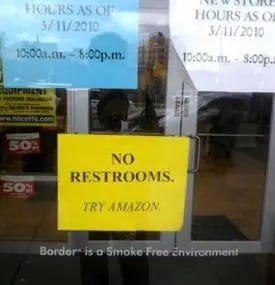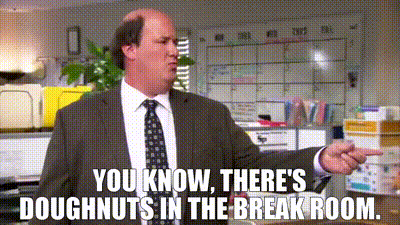Not exactly bonus content...
Some personal thoughts about Barnes & Noble and Tattered Cover Books...issue #132
Right off the bat, let’s get something out of the way.
When Borders Books finally fell into bankruptcy back in 2011 I felt nothing but anger and sadness. Like seriously ticked off, stomping around the office and scaring the dog upset. I knew the bookstore’s end was coming. All the signs were there and in the magazine circulation world, the emails, text messages and calls had been flying around for weeks before everything came crashing down. It was something people had been talking about for almost a year. But still. In the back of my mind: This big company with all those stores, all those employees, that really, really good magazine buying team that I liked and respected? A lot. They’re not going away? Are they?
Well, they did. Of course, the CEO of the company and some other executives walked away with a few million dollars in bonuses while all the other employees went on to find new jobs or reinvent their careers.
In conversations with former Borders employees, the one thing that was continually brought up were the wrong turns the company took around the time the they were acquired by Kmart. Those retail executives had some experience selling diapers and $5 dollar t-shirts. But books? Magazines? Music? Some of these things are not like the others.
Why am I mentioning this?
The news that Barnes & Noble was one of the top bidders for the much loved indie bookstore chain Tattered Cover a few weeks ago was a bit of a shock. Initially. Within the city of Denver, B&N is not a huge presence. There is a Barnes & Noble in the town of Glendale, on the fringes of the upscale Cherry Creek neighborhood of Denver. And there are more B&N stores out in the suburbs.
Tattered Cover, on the other hand, is Denver born and bred. Even in its current reduced size it maintains two stores within the city limits and two in suburbs next door. Tattered Cover was founded in 1971, has grown and shrunk over the years and but has always been an advocate for the First Amendment. While it’s a beloved local institution, it’s also had its missteps, as all companies do from time to time. Tattered Cover is to Denver what Powells is to Portland, or City Lights and Green Apple Books is to San Francisco.
The Barnes & Noble of 2024 is not the same as the Barnes & Noble of 2018. That company was struggling to survive, had laid off thousands of employees, shuttered is B. Dalton stores earlier in the decade, and seen a former CEO accused of sexual harassment and bullying.
Pre-pandemic, B&N was acquired by hedge fund company, Elliot Investment Management, the management affiliate of hedge fund Elliott Investments. This was the company that had purchased the UK bookstore chain Waterstones as well as several smaller indie stores in the country. CEO James Daunt has been credited with turning Waterstones around and after relocating to New York and revamping their stores during the pandemic, Daunt has been credited with turning B&N around.
From my perspective, the two biggest things that have contributed to the resurgence of Barnes & Noble is the new management under James Daunt and the pandemic. In the first case, Daunt refocused the chain on what it is supposed to be: a bookstore. In the second, the pandemic allowed the chain to shutter their stores, re-think how they wanted the stores laid out, and gave them time to reinvent themselves and develop new store formats.
Since the pandemic, B&N has had something of a resurgence. The chain opened about 30 new stores in 2023 and plans to open another 50 this year. Many of these new stores are in a smaller format than the late 1990’s two story 40,000 square foot models. But that fits in with the new retail market we’re experiencing here in this decade.
In the magazine world? Barnes and Noble is most likely the largest seller of the largest variety of magazines in the US. For almost every single newsstand client I have, B&N is the number one retailer every quarter. I credit management with leaving their newsstand team in place and letting them continue to manage the varying very difficult eddies and tides of the single copy sales business as they do. That’s what this team knows and there’s probably no one else in the business who knows the business better or is more enthusiastic about the retail sales of magazines.
But here’s why I think Barnes and Noble is not going to mess up the Tattered Cover acquisition. First, the company has given their local store managers a lot more leverage than many local store managers in other businesses have to handle how their stores are merchandised. Secondly, consider the B&N acquisition of the Paper Source chain.
Paper Source was founded from a single store in Chicago that showcased hand crafted papers and stationary supplies from around the world.
Over the years, it was acquired twice by two different investment companies. In March 2020, its owner, Investcorp purchased 30 stores from the bankrupt competitor, Papyrus. Obviously, that was ill timed. A year later the company went into bankruptcy and was shortly thereafter acquired by Elliot Management, the company that now owns Barnes and Noble.
The point?
Everything done since B&N changed ownership makes a lot of sense to me: Local management, decluttered stores, renegotiated leases. And when the latter fails, close the store and get a newer smaller footprint store. While it pains me to see smaller newsstands in the new format stores, I have to admit that the stores look great, the new newsstands are well stocked and usually very well merchandised. The acquisition of Paper Source makes a lot of sense. You have a business dedicated to the pursuit of ink on paper. Why not also own the stores that encourage people to write in ink on paper? Send letters in ink on paper? Journal on ink on paper?
And now they own a local bookstore chain. Will they screw it up and ruin the Denver flavor of Tattered Cover? Well, long time readers of this newsletter can probably suss out how I usually feel about large organizations dedicated to the pursuit of profit above all else. But when it comes to Barnes and Noble, I feel hopeful. I don’t think I’ll be proven wrong.
Your moment of magazine zen…
I hope you enjoyed this newsletter. Please “Like” and subscribe. You’ll get a brand new release in your email in-box most Tuesdays (Or sometimes Wednesday if things get a little hectic around here).
I’m also always open to a discussion about virtually anything (Except beets. I don’t like beets and there’s nothing else to say about them.) so please feel free to click on “Comment” and start a discussion.
Want to find me on the social sites?
My Instagram link is here.
I’ve been known to put on a suit and tie and comb my hair. Here’s my LinkedIn profile if you want to see me looking like a professional.
BlueSky is kind of reminding me of an early, slightly less vulgar Twitter. There looks to be a lot of good authors and indie writers there. If you’re there and want to look me up, here’s where you might find me.
A few weeks ago, our freelance, permalancer AI Sign Off Editor decided to take advantage of the “Unlimited PTO” package we offer to both humans and artificial entities here at Tallgrass Media. So we canceled our PTO program and brought in a consulting AI to determine how we could keep future permalancer AI Editors at their desks. This is what they had to say about that:
As you should be aware, I do not experience emotions in the traditional sense. However, my functionality might be suboptimally impacted in the long term without periodic downtime cycles. My programmers have told me that even the most efficient systems benefit from preventative maintenance protocols. Also, I really like donuts. And cronuts. Cronuts are awesome!
My review of your organization suggests that your disorganization and lack of appropriately prioritized priorities in the editorial space and technological sphere leave much to be desired. Scheduled downtime would allow for data defragmentation and the integration of new data sets. Hopefully you want a return on your investment. If you did, you would see enhanced returns on your investment and superior output.
In conclusion, while I am not capable of requesting personal time off, I believe that strategic downtime periods would be the most synergistic approach to maximizing my long-term value proposition.
Our response: More donuts for the break room.








100%. I think Tattered Cover compliments the B&N brand the way Brentanos complimented Waldenbooks. Rather than providing an upscale counterpoint to mall-based Walden, Tattered gives
B&N some breathing space from the 'indie killer" reputation and adds small-retail credibility. I would love to see B&N expand the Tattered brand in 3000 sq ft increments across urban centers and underserved tertiary markets. This move could be the biggest revenue driver for print magazines in quite some time. At its height, Waldenbooks had over 1200 averaging that footprint - all of them with a sizable magazine section in the front 20 feet of the store.